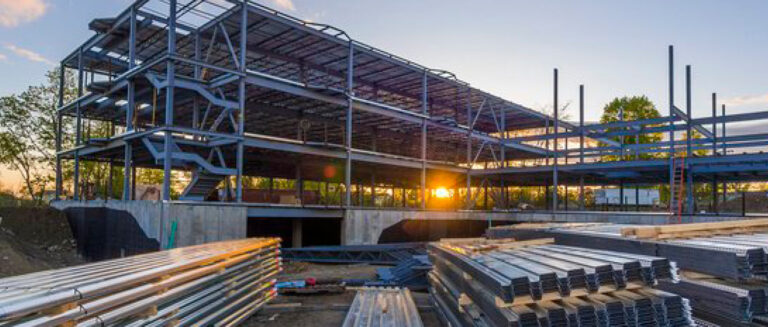By Kim Slowey, Mary Tyler March and Laurie Cowin for ConstructionDIVE
After a robust 2017, commercial construction companies are anticipating an even stronger 2018, with the majority reporting they plan to expand their staffs, according to Dodge Data & Analytics.
As professionals seek to map out 2018 and beyond, there are a number of trends shaping the construction industry. Some are evolutions of past years, such as offsite construction and an increasing reliance on technology, and some trends are new, such as a focus on resiliency after the most damaging hurricane season on record and devastating fires in California.
Other trends that will shape construction revolve around policy, both federal and state, the ongoing labor shortage and gargantuan projects, including Amazon’s much-anticipated HQ2.
Resiliency Takes Center Stage
Resiliency is set to be one of the construction industry’s watchwords for 2018 after last year’s onslaught of hurricanes, heat waves, cold waves, flooding, tornadoes and wildfires. Property owners took a total financial hit that is still climbing and could reach nearly $400B, according to Vox.
Rather than throwing up duplicate replacement structures, more owners will likely heed the call of organizations like the U.S. Green Building Council and demand resilient site and structure features. The USGBC announced it would adopt construction standard RELi, which awards points for resilient features such as adaptive design for extreme weather events and their resulting hazards, communications and first-aid resources.
Short on Labor – Still
The construction industry will continue to contend with a limited supply of skilled craft workers. Officials in various parts of the country have used words like “dire” and “scary” to describe the availability of qualified labor as younger individuals resist construction as a career option and more baby boomers retire.
Industry groups like the Associated General Contractors of America and the Associated Builders and Contractors have for years lobbied lawmakers for increased federal, state and local funding for trade school, high school and middle school trade education programs as a way to help create a construction industry labor pipeline, and those efforts could pay off and help ease the problem.
Meanwhile, the industry is turning to alternative construction methods to make up for the short supply of workers.
Offsite Construction on the Rise
For much of 2017, offsite construction and investment in the delivery method was a key trend. Offsite startups like Katerra and FullStack snagged millions in funding, while a growing number of U.S. contractors partnered with prefab companies to fold the method into their operations.
Increased pressure from supply-side challenges and a growing need to jumpstart productivity will continue to drive offsite into the mainstream. Traditional contractors’ desire to increase project efficiency with offsite components is opening the door to greater collaboration between general contractors and offsite fabricators.
With larger companies like Turner Construction and Gilbane adding project manager roles for offsite to their payrolls, the delivery method only stands to build momentum.
Investment Up for Public Transportation
Former transportation secretary under President Barack Obama, Anthony R. Foxx, talked at Autodesk University in November about the state of infrastructure in the U.S. He said that focus now is on integrating existing infrastructure because end-to-end systems already are in place. “We can’t look at modes of transportation as separate and distinct anymore,” he said. “It’s all one whole.”
Beyond traditional rail and bus systems, the country is exploring higher tech options, such as high-speed maglev trains and hyperloop systems, several tunnels of that have been okayed in Maryland and California.
Technology and Automation Tackling Jobs
At Autodesk University in November, Autodesk CEO Andrew Anagnost grabbed the automation bull by the horns, saying, “Instead of worrying about automation taking our jobs, let’s have a conversation about where automation can take us.”
Construction tech earned the distinction as Trend of the Year in the 2017 Construction Dive Awards. The industry saw $433M of funding in the first nine months of 2017 alone. Out of the 56 total deals, two of them were valued at more than $50M
New Policy Regulation Impacting Businesses
The House and Senate approving President Donald Trump’s tax overhaul capped 2017. Although not construction-specific, it certainly will have a significant impact on businesses. The public construction sector will benefit from private-activity bond financing and contractors structured as C-corporations and pass-through entities will benefit from tax relief. PAB use, however, may limit and lock out design professionals from taking advantage of the new lower pass-through tax rate.
Many also will be keeping an eye on the infrastructure bill, which may be revealed later this month, and has the potential to put up to $1T into the pipeline.
Giant Companies Expanding Spaces
While last year saw the addition of new high-tech campus facilities from the likes of Google and Apple, 2017’s hype around a second new North American Amazon headquarters will likely fuel increased momentum for similar expansions in 2018.
Software giant Microsoft is slated to begin a multi-billion-dollar redevelopment of its existing Redmond, WA, campus later this year, joining Apple, Google and other tech giants that are expanding their capacities “at home.” Meanwhile, companies like Marriott and General Electric are expected to break ground on new headquarters developments.
As more firms continue to build out their facilities, many are also likely to add infrastructure needed to support their operations. Data center construction, especially, is taking off as companies increasingly amass unprecedented amounts of information in their servers.
AR/VR, Wearables and Drones Transforming Jobsites
In the face of mixed-reality headsets, such as Microsoft’s HoloLens, and wearable devices, such as Triax’s Internet of Things-enabled sensors, it’s a safe bet that high-tech wearables and augmented and virtual reality will continue to infiltrate jobsites. Two of the greatest benefits these technologies offer are safety and efficiency — both areas where the construction industry tends to struggle.
Meanwhile, more contractors are looking to drones to survey sites and improve upon worker safety as well.
Read more at ConstructionDIVE.

